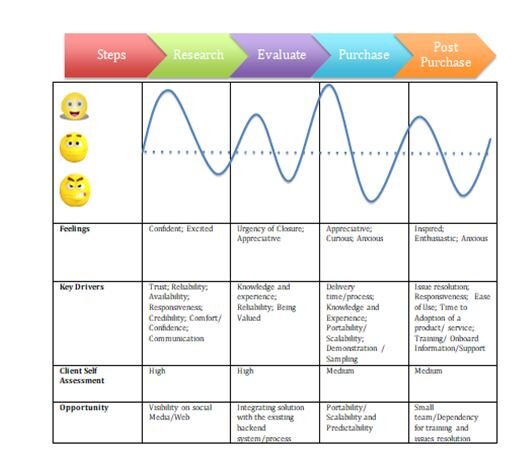How Customer Journey Mapping stands out as a starting point for your Customer Experience Management Initiative
Do you ever wonder when was the first ever Customer Journey Map(CJM) created? It was the year 1998 when Oxford corporate consultants introduced this for service design to support brand proposition and corporate mission for Eurostar.
Since its existence, about two decades ago, it has been a crucial topic of discussion when one is brainstorming an approach to enhance customer experience for an enterprise.
Customer Journey Map(CJM) is a tool that is excessively used today across industries for all sectors because of its proven benefits in all these years. CJM is a visual representation of every experience a customer has with a brand/organization across touch-points. It’s a story of the experience derived from customer’s engagement culminating into a relationship with the organization.
While the technique is evolving and usage has increased over time, the practicality and objectivity of it is still debated. Customer Journey Mapping (CJM) when is offered as a solution, its return on investment and sustainable implementation is always a most critical pointer that needs a mention.
Understanding Customers through Customer Journey Mapping(CJM)
Over the years, there have been numerous researches and real world case studies suggesting that for an enterprise that is new to the concept of Customer Experience Strategy, Customer journey Mapping is recommended as a first step.
Enough has been said and written about what CJM means and how it helps organizations. At a broader level few of the listed benefits are:
Build 360-degree view on your customer
Re-evaluate business strategies from a different perspective, i.e., always keeping customer in center of your interactions, processes and policies
Cultural shift by ensuring customer centricity as a core competency irrespective of your role and level in the organization.
The way this technique comes into play, brings everyone across the table and synergizes on who the customer is and what it means to the organization mission and vision. The process helps to gather valuable insights on the consumers feelings, motivations, expectations, questions or concerns at each and every interaction point through well researched Personas.
The picture below is an example of persona depiction before we start working on CJM for a startup that builds Customer Relationship Management (CRM) products.
Figure1: CRM Technology for Restaurants – Persona Overview
Customer Journey Mapping (CJM) is a data driven tool to understand customer expectations, motivations of a brand/organization. The journey map, that is drawn from an experience of a persona, is intuitive in nature and simpler to understand to minimise the customer effort.
Mindset Shift through Customer Journey Mapping
The success of the “Customer Journey Map” depends a lot on the depth of adoption and also the rigor and continuity we maintain in the process.
Depth of Adoption also envisages that it
Understands Customer Behavior including expectations, motivations, and what they are looking for when interacting with a brand/organization across touch-points. Prior qualitative research for different personas, feedback reports, website analytics, sales-report and employee's point of view comes handy to support and build this understanding.
Is contextual and relevant for the customers. For instance, a touch-point that is important and is affecting customer retention is still not prioritized. Post-purchase engagement with a customer can get a miss in the pursuit to attract more customers.
Reduces mental/physical/time based effort of the customer by understanding and simplifying the journey that is easy and efficient for the customer. Data and feedback will help to evaluate each touch point or the touch-points that need prioritization to create the needed experience.
Figure 2: Depiction for CJM of a product
When adopted correctly by practitioners, it's a discipline that enables employees to shift their perspective from their own to more Customer’s view. Specifically, journey maps created through extensive discussions with key relevant stakeholders can support to minimize individual bias and create a holistic view. It is insightful and tremendously engaging for the employees.
Eventually with a standard and common understanding of customer expectations across the organization as well as an Omni-channel presence would lead to frictionless journey and streamlined communication.
When implemented correctly, Customer Journey Mapping(CJM) helps in driving customer loyalty, reducing operational and related costs, brand positioning and most of all maintaining consistent messaging across all channels that a consumer would adopt to interact for a product or service.
Identifying Customer Success Champions
If leadership of an enterprise is committed to this effort and focuses on getting it the attention and trust it requires, it is a simple tool that goes a long way to keep everyone aligned to the same mission.
As mentioned earlier, Customer Journey Mapping (CJM) triggers a shift in how the employees and leaders approach their respective functions and reorganize their way of working through insightful learning from a Customer’s point of view. As you progress towards building the maps, you initiate an immediate change in mindset and also demonstrate short term as well as long-term results.
One of the key outcomes can also be the identification of “Customer Success Champions” in an organization. These Customer Success Champions can be the Voice of the Customer (VOC) and thus with authority can initiate, influence various efforts so that the Customer voice, opinions are understood and thus acted upon.
Since CJM helps understand both internal and external influences to companies growth, just the internal impact driven by this effort could help win a great deal of customer success and hence improve customer retention.
When we say, customer experience is a key differentiator in the market, Customer Journey Mapping (CJM) is one of the most practical tools and techniques to make it work in favor of an organization.
Creating a seamless and engaged Customer Experience
There are a number of notions around mapping of customer journey and complication in understanding and developing knowledge around it. This has led to the tool at present being majorly used in larger organizations.
However, it is important to mention that this is a technique that can be learnt and easily translated to practical means with little effort and some basic training. Irrespective of the size of organization, it is highly recommended that we use this technique to our advantage and make the most of it.
Figure 3: Customer Journey Mapping quantifying the emotions felt at Key Touch points
Positive impact on Business Metrics and ROI
For those who have applied customer journey maps in their strategy and operational business decisions have been very optimistic with the outcomes.
This exercise allows one to clearly
lay out the consumer interactions as they are.
also have a wider visualization because you are not just depending on imaginations or hearsay.
The process allows you to define various personas for each segment and consider the voice of the customer, the real data point or direct experience from the persona to go through the interaction at each touch point.
The insights are not one off discussion, rather, drawn from regularly going back to the map, preferably monthly and amending any changes as situation or scenario may demand.
With all the returns on investment customer journey mapping may bring, it leads to inducing reduction in customer loss, lesser issues or escalations and definite improvement in scores like net promoter score or customer engagement.
Not to forget when working on your Customer Journey Maps
When you deploy customer experience management using customer journey mapping, it is always recommended to go through it with all possible personas, not just for your consumer, but also other stakeholders and employees too. This would give a road map for business growth in entirety.
A case in point is of Customer Journey Mapping (CJM) in a legacy organization that used it to comprehend, understand the present state of their customer experience basis the evolving behavior and expectations. CJM supported the organization to build a 360-degree view of consumer insight, created customer service recovery solutions and mechanism for feedback and insight sharing across the organization breaking the silos functioning. This helped them create a roadmap to build more avenues while simplifying the existing processes for consumers to engage.
Hence, alignment of strategies with the organizational vision was supported by Customer Journey Mapping(CJM). Read the complete case by clicking here .





